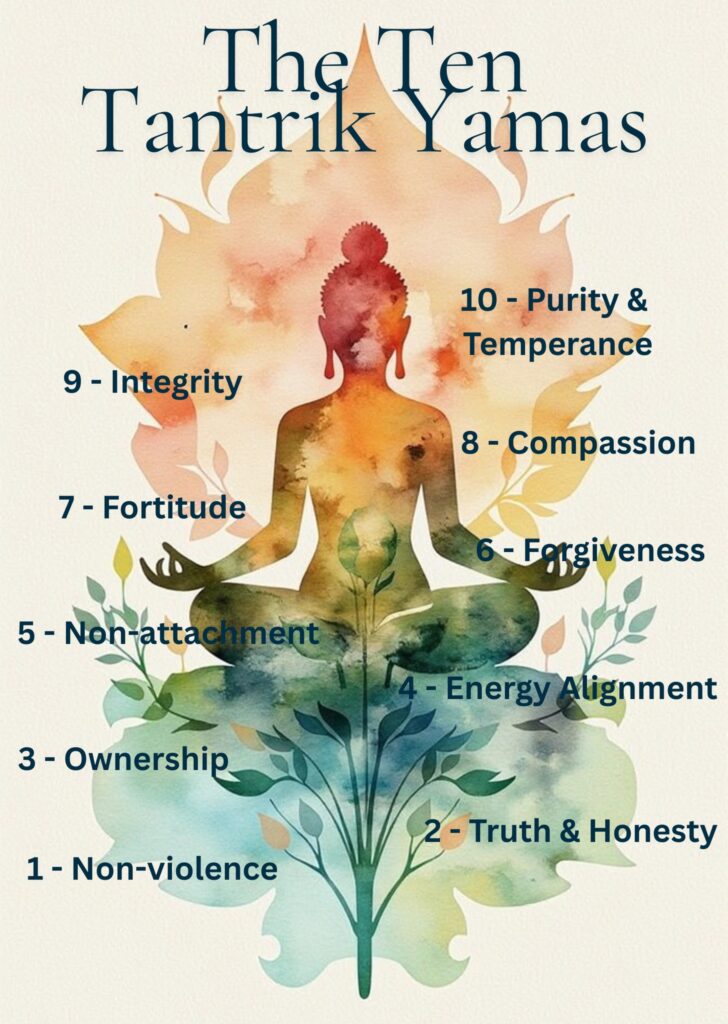The Ten Tantrik Yamas are an expanded foundation of Practical Guidelines for Self-Care and the Cultivation of Awareness in Spiritual Practice. Expanded because they go beyond the five listed in the Yoga Sutras—the ten Tantrik yamas are presented as both the beginning of the path and a means of stabilization after spontaneous awakening in multiple source texts and traditions.
This dual function reflects a profound understanding of human transformation, that ethical-energetic alignment is both preparatory and remedial in the yogic journey.
Why the Yamas Are Foundational and Stabilizing
1. Beginning the Path: Purification of the Field
Across the Yoga Sutras, Haṭha Yoga Pradīpikā, Sandilya Upanisad, Śārada Tilaka Tantra, among others, the yamas are consistently emphasized at the outset because they:
- Purify the subtle body to allow prāṇa (life force, energy) to move harmoniously.
- Restrain the human propensity for attachment & aversion, which otherwise distort perception and energy, i.e., balance perspective.
- Prepare the foundation for safe arousal of Kuṇḍalinī by grounding the nervous system, stabilizing intention, and cultivating sattva (purity at every level).
For instance, the scriptures tell us that even physical practice (yoga āsana) will not be fruitful without yama-niyama, and many of them list a full complement of ten yamas, which include practices like self-care through non-violence, the cultivation of awareness through practices of temperance, forgiveness, mental-emotional fortitude and steadfastness, compassion, etc., and deep understanding of the human condition through the proper balancing and alignment of your psycho-physical system and subtle energy bodies with the macrocosmic order.
These aren’t mere moral codes—it isn’t dogma—but real energy-governing principles that cultivate inner equipoise.
2. After Awakening: Grounding & Integration
Spontaneous awakenings—whether triggered by trauma, meditation, breathwork, psychedelics, or grace—often open energetic centers prematurely, without the stabilizing container of ethical and psychological integration. Here the yamas serve to:
- Rebuild the ego in alignment with essence.
- Prevent prāṇic derangement, hallucinations, psychosis, or obsessive behaviors.
- Root spiritual experience in the relational, embodied world, avoiding spiritual bypass or dissociation.
In tantric terms, yamas refine the receptacle to hold higher voltage energies without distortion.
Parallels in Global Traditions
Other wisdom traditions also begin with ethical, energetic, mental-emotional, and physical regulation. These include:
Buddhism’s Eightfold Path begins with right speech, right action, right livelihood, etc., and Vajrayāna Tantra (Buddhist Tantra) practice requires a foundation of ethical vows i.e., guidelines or restraint practices) before mantra or deity yoga.
Christian Mysticism has its purgatio as the first stage, involving restraint of passions and practices of humility, silence, and moderation among others.
Sufism begins with etiquette, sincerity, and self-observation via similar practices of ethical purification that both precedes and stabilizes the spiritual states and stations).
Daoism cultivates virtue and harmony with the Dao through dietary, behavioral, and sexual restraint—preparing the body-spirit system for energetic awakening and a deeper engagement with inner alchemical practice.
Kabbalah’s ten spheres of intelligence serve as ethical-energetic templates of the micro-macrocosmic order, reflecting a divine quality that the practitioner is called to embody. Energetic virtues that refine the vessel to receive and channel Divine Light.

The Yamas Regulate the Psycho-Energetic System in Direct Relation to Kuṇḍalinī. Examples include:
The practice of Yama #1 Ahimsā (non-harm) has the energetic function of calming the mūlādhāra chakra, reducing reactivity, and anchoring awareness.
The practice of Yama #2 Satya (truthfulness) is said to align viśuddha (throat) chakra, supporting coherent expression.
Yama #6 Kṣamā (forgiveness) opens anāhata chakra making way for devotion and peace.
Yama #7 Dhṛti (mental-emotional fortitude) balances ajñā chakra (third eye), keeping intention stable amid visions or siddhis (powers or gifts that naturally arise as awareness deepens).
Yama #10 Mitāhāra (moderation, temperance) supports the manipūra chakra, strengthens agni (digestive fires) to enhance physical and mental digestion.
Yamas create a stable current through the suṣumṇā (the central channel of the energy body), clearing blockages in granthis (knots of consciousness). Without them, even strong prāṇa will leak, scatter, or activate latent traumas.
And these are just a few examples! And a few of the reasons why the sages of every time-honored, time-tested tradition acknowledge these Yamas, or Guidelines for Self-Care and Cultivation of Awareness in Spiritual Practice, as both the beginning of the path, as well as the practices that preserve and maintain it. The traditions are time-honored because they bear the sweet fruit of the practice. Time-tested means there’s a lot of evidence for the veracity of these statements.
Ethical disciplines aren’t external impositions. They are precise energetic alignments. Across global traditions, this inner cultivation is required before mystical experience, and again after, to contain, stabilize, and integrate. In the yogic context, the Ten Tantrik Yamas serve as the protective container for Kuṇḍalinī—whether it rises by design or accident.
Over the past year, I’ve had the honor of guiding satsangas (gatherings of good people for practices in truth) on each of the Ten Tantrik Yamas, one by one. Many have witnessed firsthand the clarity, vitality, and groundedness these principles bring—not only to spiritual practice but to everyday life and the often-chaotic process of awakening.
Now, these teachings are available as a self-paced program: over 20 hours of in-depth video content, support files rich with scriptural references and glossaries, curated literature, and a wealth of guided meditations and practical tools to integrate these foundational energies into your lived experience. You can explore the yamas as a complete package or as individual modules from the program library. For those on an active path of awakening, I also offer a monthly subscription that grants full access to the entire library along with ongoing personal mentorship.
If you feel called to stabilize, deepen, and harmonize your journey, I warmly invite you to step in. This work is here to support the real transformation you’re already living.

…is a Saiva Tantrika, Gyana Yogi and founder of Uma Maheshwara Yoga & Ayurveda. David has an MA in Semiotics, lives in Japan with his family and works as a coach in L & D, devoting his time to developing science-based tools and programs that help people reach the fullest potential of the human condition.
Discover more from REAL YOGA
Subscribe to get the latest posts sent to your email.

